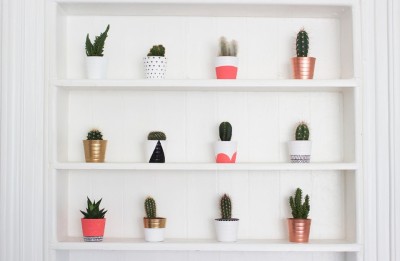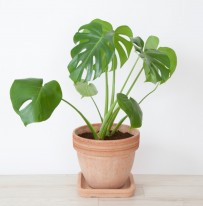
House Plants can brighten up a home easily and most of them do not require much maintenance. They are not only aesthetically pleasing, but have health benefits and are efficient, because they improve air quality. Below is a list of top ten houseplants that you can get your hands on, for the interior of your homes.
Number 10: Heart Leaf (Philodendron Oxycardium)
The Heart leaf plant in particular, is known for its its appearance that takes up the shape of a heart in the shiny green leaves. It is best known for being a vinal houseplant, because it is easy to grow, being able to tolerate dim lights and dry air. This plant is good at battling formaldehyde from sources like furniture. However, it is toxic when eaten so should be avoided if around young children or pets.

Image source: http://www.triadplantco.com/listplants-details.php?type=philodendron
Number 9: Panda Plant (Kalanchoe Tomentosa)
The Kalancho panda plant stands out with its fury leaves. It is one of the easiest succulent plants, which is easy to maintain and care for because it stores water so rarely needs watering. It has a blue-grey appearance with brown hairs on the edges of the thick green leaves. It remains aesthetically pleasing all year round, so there should be no worries concerned with changes in the season. In addition, the panda plant is tolerant of dry air, therefore being a good interior plant for heated homes, all it needs is to be placed where there is plenty of light and it will live for many years.

Image source: http://www.coachwoodnursery.com.au/succulent-workshops–gallery.html
Number 8: Swiss Cheese Plant (Monstera Delicosa)
This houseplant is distinctly efficient for it ability to be a humidifier in air conditioned homes, it is also effective having other extensive air cleaning properties. They are easy to grow and need to be placed in an area of balanced levels of brightness and shade. Ideal locations for the Swiss cheese plant are perhaps conservatories or large rooms. It has a peculiar appearance with holes or slits in the leaves, which are green and glossy, however these slits do not appear till it is more matured.

Image source: http://www.gardeningknowhow.com/houseplants/swiss-cheese-plant/proper-care-of-a-swiss-cheese-plant-swiss-cheese-plant-propagation.htm
Number 7: Chinese Evergreen (Aglaonema Crispum, “Deborah”)
The Chinese evergreen plant filters out a variety of air pollutants and leads to removing extra toxins as time and exposure continues. Even if placed in an area of low light it will still blooms and produces red berries. In comparison to other houseplants, the Chinese evergreen requires little effort to care for, and will still be durable. They are best suited in mid to low light conditions or indirect sunlight, where there are warm temperatures. They have leathery green leaves and grow flowers which don’t particularly stand out, so it doesn’t look too showy.

Image source: http://www.gardeningoncloud9.com/200903/suitable-plants-indoor-gardening/
Number 6: Bamboo Palm (Chamaedorea Sefritzii)
The bamboo palm is also known as the reed palm, it thrives in indoor shady locations and usually grows berries and flowers. It is best known for filtering out both benzene and trichloroethylene and is often placed around furniture It is a good household plant because, it can be placed around furniture that could be exposing the poisonous gas, formaldehyde, not only that it has a striking appearance. This plant needs a little more care to maintain its appearance, such as particular temperature conditions, fertilizing and repotting.

Image source: https://www.pinterest.com/pin/195062227584161993/
Number 5: Rubber Plant (Ficus Elastica)
This plant is an easy to maintain houseplant, which tolerates dim light and cool temperatures. It can survive in less light than other plants of its size usual amount and is in particular effective for removing gases such as formaldehyde. It is a popular ornamental plant with its shiny leather type leaves and grows to a manageable height indoors. Within a home it is best suited as a centrepiece such as on a table or windowsill when it is of a short height, once taller it will stand great by the television or at the entrance of the home.

Image source: http://www.floristcart.com/fs596-rubber-plant.html
Number 4: Warneck dracaena (Dracaena deremensis ‘Warneckii’)
This plant is great for improving indoor air quality, as well as being one the most colourful and easy to be cared for plants as it needs little sunlight, even thriving on artificial light. Overlapping on its thin stem, the warneckii grows striped leaves of grey, green or white in clusters, making it rather striking. They work well when placed on a windowsill or as a part of a mixed group of plants.

Image source: http://li133-208.members.linode.com/houseplant/dracaena-deremensis-%E2%80%98warneckii-dracaena-warneckii
Number 3: Peace Lily (Spathiphyllum)
The peace lily is a lovely houseplant to have, with its white blooms and green leaves. They are easy to care for, but need weekly watering and shade. These plants brighten up living spaces and are ideally placed where there is more light, where they produce white spathes and more flowers, however they can also grow in shady areas and will look more like plant leaves rather than a blooming plant. In addition, they are top listed for being a plant which can remove all three of the most common VOCs (Volatile organic compounds) – formaldehyde, benzene and trichloroethylene, not only can they remove VOCs, they can fight the liquid hydrocarbons toluene and xylene.
Image source: http://www.spiliyifloral.com/product/calming-grace-peace-lily-plant-4-5-inch-diameter/display
Number 2: Pincushion Cactus (Mammillaria)
Pincushion cactus is among one of the most common household plants in the cactus species of ball-shaped cacti. They often flower indoors and remain small taking up the form of single balls or clumps. To grow pincushion indoors they need to placed somewhere where there is a lot of light, such as on the windowsill. This is a small plant, so is a good houseplant because it doesn’t take much space and deposit access leaves. This succulent plant is covered in white spines, which is difficult when having to repot or move about, being best handled with thick gloves.

Image source: http://www.bhg.com/gardening/houseplants/projects/top-10-succulents-for-home/
Number 1: Aloe Vera
This winning plant for the indoors is great, specially when placed in a bright kitchen window. Aloe vera is succulent and has good air-clearing abilities such as, clearing formaldehyde and benzene, which are secondary products for more than just chemical-based cleaners and paints. Further this plant not only has air clearing abilities, it is known for its production of a healing gel for cuts and burns, which is produced within the leaves. The plant has varied coloured leaves with small white teeth, which are short and grow around the plant’s centre base.

Image source: https://www.pinterest.com/source/zonavazona.com/




 POSTED BY
POSTED BY 

